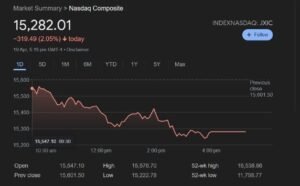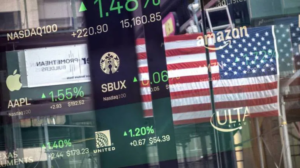On Friday, the Nasdaq and the S&P 500 experienced significant declines, while Treasury yields decreased, as investors grappled with underwhelming earnings reports, uncertainty regarding central bank actions, and geopolitical tensions.
Gold and crude oil prices climbed as investors closely monitored escalating tensions in the Middle East.
Among the three main U.S. stock indexes, the Dow was the sole performer in positive territory, while the Nasdaq faced a 2.05% decline, primarily due to the drag from large-cap tech and momentum stocks.

The trading session marked the sixth consecutive day of losses for both the S&P 500 and the Nasdaq, representing the longest downward trend since October 2022.
For the week, the S&P 500 and the Dow experienced their most significant weekly percentage declines since March 2023, while the Nasdaq recorded its largest weekly drop since November 2022.
Following Israel’s retaliatory drone strike against Iran, tensions in the Middle East seemed to stabilize as Tehran downplayed the incident, indicating a potential effort to prevent further escalation in the region.
Peter Tuz, president of Chase Investment Counsel, noted a heightened level of concern in the Middle East, suggesting it’s at its highest since October 7, with many keeping a close eye on the situation.
Amidst the ongoing first-quarter earnings season, analysts have revised down their expectations, now foreseeing a 2.9% year-on-year growth in aggregate S&P 500 earnings, down from the 5.1% estimate earlier in April, according to LSEG.
Chicago Federal Reserve President Austan Goolsbee emphasized the appropriateness of the Fed’s current restrictive policy, citing economic strength and the slower-than-anticipated progress in curbing inflation towards its 2% target.
In Friday’s trading, the Dow Jones Industrial Average climbed 0.56%, reaching 37,986.4 points, while the S&P 500 fell 0.88% to 4,967.23 points, and the Nasdaq Composite dropped 2.05% to 15,282.01 points.
Impacts on other parts of the world
European shares initially dipped to their lowest level in over a month but rebounded from intraday lows as  concerns over Middle East tensions eased and robust earnings provided some support. The pan-European STOXX 600 index closed down 0.08%, while MSCI’s global stocks gauge shed 0.84%.
concerns over Middle East tensions eased and robust earnings provided some support. The pan-European STOXX 600 index closed down 0.08%, while MSCI’s global stocks gauge shed 0.84%.
Emerging market stocks declined by 1.30%, and MSCI’s Asia-Pacific shares outside Japan closed 1.61% lower, with Japan’s Nikkei losing 2.66%.
As investors favored safe-haven assets amid fears of a broader Middle East conflict, Treasury yields edged lower. The benchmark 10-year notes rose in price to yield 4.6228%, while the 30-year bond also saw gains.
The dollar remained relatively stable after initial volatility, with the dollar index falling marginally and the euro slightly up. The Japanese yen strengthened slightly against the greenback, while sterling weakened.
Initially, crude oil prices dipped on easing supply concerns following Iran’s restrained response, but they later settled modestly higher amid ongoing uncertainties stemming from geopolitical instability. U.S. crude settled at $83.14 per barrel, up 0.50%, while Brent settled at $87.29 per barrel, marking a 0.21% increase on the day.
Gold continued its upward trend, aiming for its fifth consecutive weekly gain, with spot gold rising by 0.4% to $2,386.49 per ounce.
Explaining the NASDAQ slump amidst geopolitical tensions:
Crossfire Explained
 Geopolitical crosscurrents refer to the interconnected web of political events around the world that can influence each other. In this instance, the tensions include:
Geopolitical crosscurrents refer to the interconnected web of political events around the world that can influence each other. In this instance, the tensions include:
- The ongoing war in Ukraine: This conflict has disrupted global energy supplies and supply chains, leading to inflation concerns.
- Rising interest rates by the US Federal Reserve: The Fed is raising rates to combat inflation, but this can also dampen investor sentiment and slow down economic growth.
- Tensions between the US and China: Trade frictions and geopolitical competition between these two economic giants can create uncertainty for businesses.
Why and How Did the NASDAQ Fall?
These crosscurrents have caused investors to become risk-averse. They are pulling their money out of technology stocks, which are typically considered to be growth stocks and therefore carry more risk. This sell-off has led to the NASDAQ falling in value.
Impact on the Economy
A fall in the stock market can have a ripple effect on the economy. Here’s how it might play out:
- Reduced investment: When stock prices fall, businesses may be less likely to invest in new projects and expansion, which can slow down economic growth.
- Consumer confidence: A decline in the stock market can also erode consumer confidence, leading people to spend less.
- Wealth effect: When the value of people’s stock holdings falls, they may feel less wealthy and spend less, further dampening economic activity.
The severity of the economic impact will depend on how long the stock market downturn lasts and how deep it is.
It’s important to remember that stock market fluctuations are normal, and the economy is complex with many moving parts. While the current situation is concerning, it’s too early to say what the long-term impact will be.










